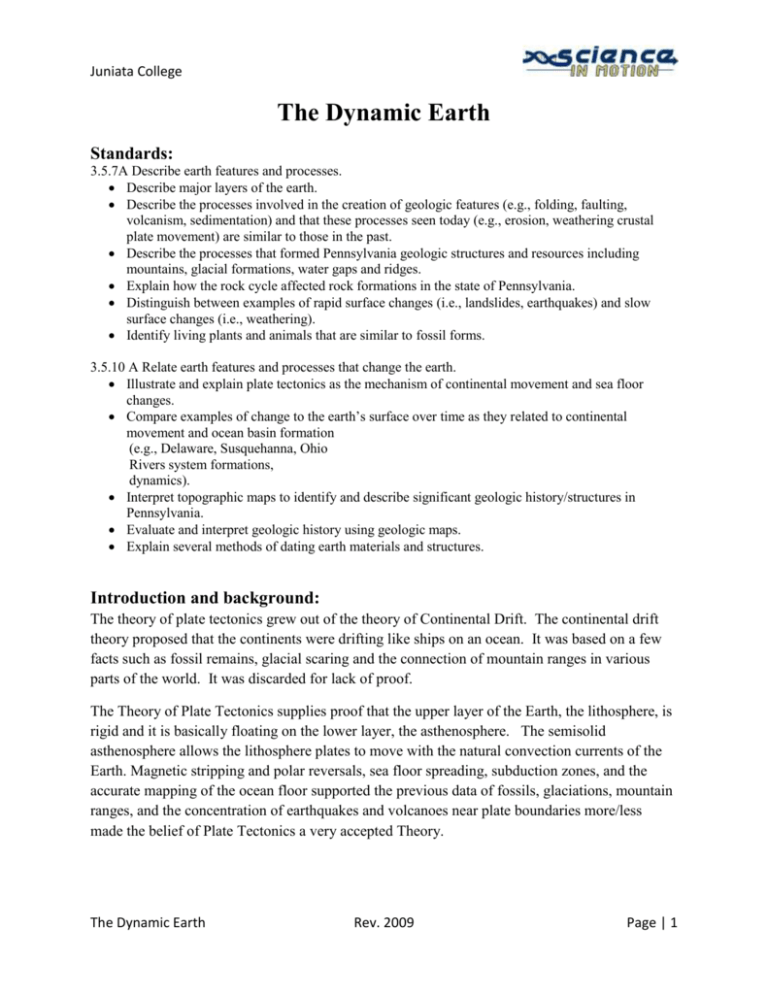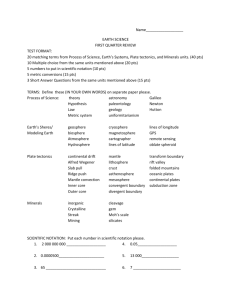The Dynamic Earth
advertisement

Juniata College The Dynamic Earth Standards: 3.5.7A Describe earth features and processes. Describe major layers of the earth. Describe the processes involved in the creation of geologic features (e.g., folding, faulting, volcanism, sedimentation) and that these processes seen today (e.g., erosion, weathering crustal plate movement) are similar to those in the past. Describe the processes that formed Pennsylvania geologic structures and resources including mountains, glacial formations, water gaps and ridges. Explain how the rock cycle affected rock formations in the state of Pennsylvania. Distinguish between examples of rapid surface changes (i.e., landslides, earthquakes) and slow surface changes (i.e., weathering). Identify living plants and animals that are similar to fossil forms. 3.5.10 A Relate earth features and processes that change the earth. Illustrate and explain plate tectonics as the mechanism of continental movement and sea floor changes. Compare examples of change to the earth’s surface over time as they related to continental movement and ocean basin formation (e.g., Delaware, Susquehanna, Ohio Rivers system formations, dynamics). Interpret topographic maps to identify and describe significant geologic history/structures in Pennsylvania. Evaluate and interpret geologic history using geologic maps. Explain several methods of dating earth materials and structures. Introduction and background: The theory of plate tectonics grew out of the theory of Continental Drift. The continental drift theory proposed that the continents were drifting like ships on an ocean. It was based on a few facts such as fossil remains, glacial scaring and the connection of mountain ranges in various parts of the world. It was discarded for lack of proof. The Theory of Plate Tectonics supplies proof that the upper layer of the Earth, the lithosphere, is rigid and it is basically floating on the lower layer, the asthenosphere. The semisolid asthenosphere allows the lithosphere plates to move with the natural convection currents of the Earth. Magnetic stripping and polar reversals, sea floor spreading, subduction zones, and the accurate mapping of the ocean floor supported the previous data of fossils, glaciations, mountain ranges, and the concentration of earthquakes and volcanoes near plate boundaries more/less made the belief of Plate Tectonics a very accepted Theory. The Dynamic Earth Rev. 2009 Page | 1 Juniata College Materials: Any of the following materials or equipment may be used. Photocopied maps of the tectonic plates Silly putty model blocks Models of lithosphere/ fault demonstration Drift Globes Models of Converging & Diverging plate boundaries Plate Tectonics assignment or puzzle-style pieces. StarLab inflatable planetarium with the plate tectonics projection cylinder Glue sticks, scissors, and/or colored pencils. Procedure A: Use the maps provided or any other photocopied maps of the tectonic plates to reconstruct a map of Pangaea as it looked 250 million years ago. 1. 2. 3. 4. 5. 6. 7. 8. 9. Follow the instructions on the procedure/ assignment that follows. Cut out the plates and glue them to another piece of paper. Students will label the plates. Label the ocean. Color on the map where specific animals lived that are now found as rare fossils such as Glossopteris, Cynognathus, Lystrosaurus, and Mesosaurus. Create a map of the world as it would look in 1 million years assuming that the plates drift an average of 1cm to 1 in a year. Draw arrows for converging boundaries, diverging boundaries and transform boundaries. Label the Mid Atlantic Ridge Color the area specific colors where specific fossils (see animals above) are found today on continents that are widely separated by water. Procedure B: You will create a map of the Earth that will look as it probably did 250 million years ago using the materials provided and any other materials you may choose. You need to create this map on one side of the blue card stock paper. The following is a list of what you map should contain and the grading criteria for the map. 1. Cut out the seven tectonic plates from the maps provided labeled "World Cut up Map" and "Pangea." You will also need to read about the fossils of the time period. 2. Glue the plates to one side of the plain unlined paper. 3. Label the plates and the continents, including Antarctica. Label the Great Ocean, Panthalassia. 4. Label, identify or include all other items specified on your map. 5. Color the prehistoric animals and plants as noted and follow directions. The Dynamic Earth Rev. 2009 Page | 2 Juniata College Pangaea Map Required components of the Future Map. Possible points Your score Title/Your name/group 5 pts. 5 4 3 2 1 0 On Time 5 pts. 5 4 3 2 1 0 Accuracy 10 pts 10 9 8 7 6 5 4 3 2 1 0 50 25 45 20 40 15 35 10 30 5 0 Tectonic plates(labeled) 50 pts. Continents (at least 7 labeled) 10 pts. 10 9 8 7 6 5 4 3 2 1 Great Ocean labeled, 2 pts. 2 0 Compas rose 2 pts 2 0 Key 5 pts 5 Directional arrows for plate movement 5 pts 5 4 Neatness 2 pts 2 1 0 Color 1 pts 1 0 Typed 1 pts 1 0 At least 2 animals/plants 2 pts 2 1 0 Panthalassia 4 3 3 2 1 0 2 1 0 Assignment 2: The World in One Million Years You will create a map of the Earth that will look as it probably will look in 1 million years from today using the materials provided and any other materials you may choose. You need to create this map on one side of the blue card stock paper. The following is a list of what you map should contain and the grading criteria for the map. The Dynamic Earth Rev. 2009 Page | 3 Juniata College 1. 2. 3. 4. 5. 6. Cut out the continents from the map provided labeled "The World Today." Glue the continents to one side of the blue paper. Label the continents, including Antarctica. Label the five oceans of the world. Label the Mid Atlantic Ridge. Label, identify or include all other items specified on your map. Label where at least two fossils of the Pangaea era would be found. Future World Map Future World Pangea Map. Possible points Your score Title/Your name/group 3 pts. 5 4 3 2 1 0 On Time 5 pts. 5 4 3 2 1 0 Accuracy 10 pts 10 9 8 7 6 5 4 3 2 1 0 50 25 45 20 40 15 Continents (labeled) 30 pts Mid Atlantic Ridge 5 pt Five oceans labeled 5 pts. 5 4 3 2 1 0 Compass rose 2 pts 1 0 Key 3 pts 3 2 1 0 Directional arrows for plate movement with subduction and divergent plate boundaries 25 pts 5 4 3 Overall Neatness 5 pts 2 1 0 Color 3 pts 1 0 Typed /Neatly printed 2 pts 1 0 At least two fossils 2 pts 2 The Dynamic Earth Rev. 2009 1 2 35 10 30 5 0 1 0 0 Page | 4








